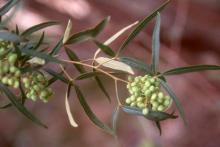Rhus lancea
Common name:
African Sumac
Willow Rhus
Karee
Pronunciation:
roos LAN-ce-a
Family:
Anacardiaceae
Genus:
Synonyms:
Searsia lancea
Type:
Broadleaf
Native to (or naturalized in) Oregon:
No
- Small evergreen tree, low branching, open, slow growing to 25 ft (7.6 m), upright, but branchlets weeping; bark gray or brown, rough. Leaves alternate, compound, 3 willow-like leaflets (trifoliate), each leaflet linear-lanceolate (terminal leaflet 12 cm × 1.5 cm), margin usually entire, rarely serrate, dark green above, paler to gray below. Dioecious - male and female plants. Flowers small, green-yellow, in dense, terminal clusters (panicles). Fruit somewhat spherical, about 5 mm, slightly asymmetrical, green then yellow, red or brown.
- Sun. Well-drained soil. Tolerates high summer temperatures, but may need some summer water in a desert environment. Susceptible to Texas root rot. Some in the arid Southwest of the U.S. concider it an invasive weed. It produces abundant seeds and also spreads by suckers and reportedly competes with native plants for water.
- Hardy to USDA Zone 9 Native to South Africa.
- Taxonomic change: The accepted name of this plant as per the Integrated Taxonomic Information System (ITIS) and U.S National Plant Germplasm Repository System is Searsia lancea





